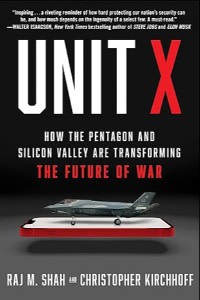Unlock the Editor’s Digest for free
Roula Khalaf, Editor of the FT, selects her favourite stories in this weekly newsletter.
On a pre-dawn patrol in 2006, Raj M Shah, a 27-year-old US air force captain, was flying an F-16 fighter jet near Iraq’s border with Iran when he realised that he did not know which side of the border he was on. That was a serious problem. Entering Iranian airspace could cause an international incident. Worse, he might be shot down. Although the F-16 was among the world’s most advanced jets, its navigation system could not graphically pinpoint his location on a moving map.
Back at base, Shah figured out a simple hack. He loaded a handheld device that he used for emails with civilian navigation software. The next time he flew a mission, Shah strapped the device to his leg. Remarkably, the $300 gadget did a better job of telling him where he was than the navigation systems of the $30mn jet. That was the first time Shah realised how far Silicon Valley had outpaced traditional US defence companies when it came to developing new technologies, especially software. It is also the opening anecdote of this riveting book.
Unit X is an exhilarating account of how the US defence industrial complex has started to come up to technological speed by tapping Silicon Valley. Written by Shah and a fellow insider who together helped lead the process, the story begins in 2015 when the then US secretary of defence Ash Carter set up a Pentagon-backed venture capital fund called Defense Innovation Unit Experimental, or DIUx, to deliver commercial innovation to US war-fighters.

That mission was ostensibly simple. The war in Ukraine has since shown the world how even commonplace technologies — such as smartphones and drones — can transform a battlefield. Back then, though, such concepts were ahead of their time. When Shah, who had left the air force to become a tech entrepreneur, and Christopher Kirchhoff, a former lead strategist for technology at the National Security Council, were tasked to head DIUx, they quickly realised how difficult their job would be. The chronicle of their struggles is especially illuminating about the bureaucratic “antibodies”, vested interests and pervasive mistrust between Silicon Valley and the Pentagon that they had to overcome. It also often reads like a thriller.
For decades, the US had maintained battlefield superiority by fielding better technology than anybody else. But around the turn of the century, that lead began to narrow. While the US spent billions on weapon systems like F-16s (with no moving maps), rivals, be they Isis fighters, crafty insurgents or sophisticated state militaries such as Russia, increasingly developed their technologies at a fraction of the cost, often using off-the-shelf components churned out in China and Taiwan.
Even as late as 2016, while civilians could routinely use smartphones to summon taxis or pay bills, US forces were often “running software programs older than the officers using them”, Shah and Kirchhoff write. In one striking anecdote, they visited the Al Udeid US air base in Qatar and saw thousands of mid-air refuelling flights organised using second world war technology: service personnel who moved paddles around a giant map. The authors realised that to get the military to actually buy Silicon Valley technology and introduce it to the battlefield, “We had to hack the Pentagon itself.”
The autonomous drones, AI-powered systems, cryptographic software and surveillance satellites that DIUx subsequently helped fund and develop, by leveraging state money with private capital, are wonderful and appalling. Who cannot be terrified by the prospect of swarming drones, but also be impressed by an app, developed for $1.5mn, that saves an estimated 25mn gallons of jet fuel every year?
Ultimately, though, Unit X is not about cool gadgets. It is about the need for the US — and by extension, the west — to maintain technological parity with its adversaries, and so deter war. Neither is a given. Unit X — a book deservedly lavished with advance praise by figures such as David Petraeus, former head of the CIA — is an urgent reminder of that.
Fittingly, the book ends in Ukraine. There, Kyiv’s western-backed forces are fighting the kind of war that DIUx originally envisaged when it was set up almost a decade ago. Ukraine’s forces, although outgunned and outmanned, have stood their ground in large part thanks to the quick adoption of rapidly developed commercial technology, some of it fostered by DIUx. The need for speed is a central lesson of the book. As General Douglas MacArthur remarked in 1940: “The history of failure in war can almost be summed up in two words: ‘too late’.”
Unit X: How the Pentagon and Silicon Valley Are Transforming the Future of War by Raj M Shah and Christopher Kirchhoff Simon & Schuster, £20, 336 pages
John Paul Rathbone is the FT’s security and defence editor
Join our online book group on Facebook at FT Books Café and subscribe to our podcast Life & Art wherever you listen